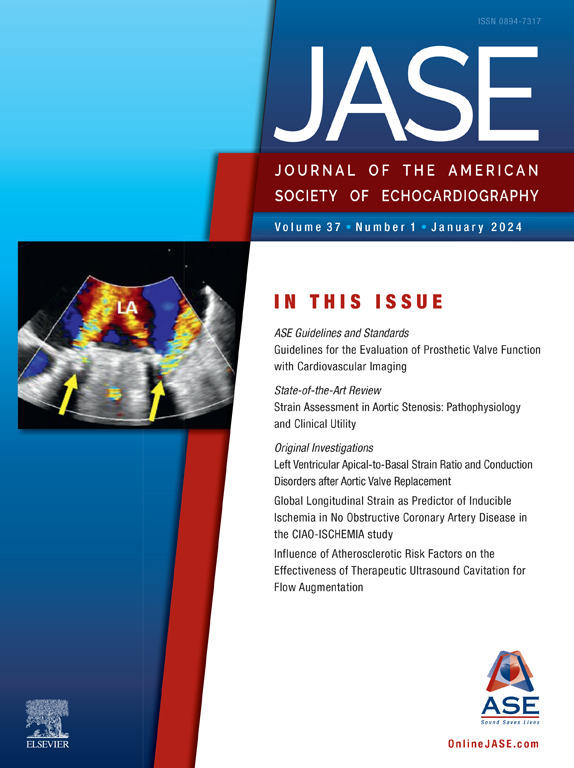Association With Outcomes of Correcting the Proximal Isovelocity Surface Area Method to Quantitate Secondary Tricuspid Regurgitation
IF 5.4
2区 医学
Q1 CARDIAC & CARDIOVASCULAR SYSTEMS
Journal of the American Society of Echocardiography
Pub Date : 2025-03-01
DOI:10.1016/j.echo.2024.10.015
引用次数: 0
Abstract
Background
Although the correction of the proximal isovelocity surface area (PISA) method has been shown to improve the accuracy of assessing the severity of secondary tricuspid regurgitation (STR), its clinical impact remains to be investigated. The aim of this study was to compare the association of the quantitative parameters of STR severity obtained from the corrected and conventional PISA methods with outcomes.
Methods
Both conventional and corrected effective regurgitant orifice area (EROA) (EROA vs corrected EROA [EROAc]), regurgitant volume (RegVol) (RegVol vs corrected RegVol [RegVolc]), and regurgitant fraction (RegFr) (RegFr vs corrected RegFr [RegFrc]) were measured in 519 consecutive patients (mean age, 75 ± 12 years; 44% men; 74% with ventricular STR) with moderate and severe STR. The end point was a composite of heart failure hospitalization and death.
Results
EROAc, RegVolc, and RegFrc were significantly larger than EROA, RegVol, and RegFr (P < .001 for all). After a mean follow-up period of 19 ± 15 months, 210 patients reached the end point. Using time-dependent receiver operating characteristic curves, the parameters obtained from the corrected PISA method were more closely associated with outcomes at 2 years than those obtained with the conventional PISA method: EROAc vs EROA (P < .001), RegVolc vs RegVol (P = .001), and RegFrc vs RegFr (P < .001) for ventricular STR. Conversely, no significant differences were detected for atrial STR. After multivariable adjustment, both uncorrected and corrected EROA, RegVol, and RegFr were independently associated with the end point. Using the new five-grade severity scheme, patients reclassified using the corrected PISA method had a significantly higher rate of events compared with those not reclassified among those with ventricular STR (P = .0086). Conversely, this relationship was not statistically significant in patients with atrial STR (P = .061).
Conclusions
Correcting the PISA method provides larger quantitative parameters of STR severity that are more closely associated with outcomes in patients with ventricular STR.
修正 PISA 方法以量化继发性三尖瓣反流与疗效的关系
背景:尽管近端等速表面积(PISA)校正法已被证明可提高评估继发性三尖瓣反流(STR)严重程度的准确性,但其临床影响仍有待研究:目的:比较修正和传统 PISA 方法获得的 STR 严重程度定量参数与预后的相关性:我们测量了连续519例中度和重度STR患者(75±12岁,44%为男性,74%为心室患者)的常规和校正有效反流孔面积[EROA vs. corrected EROA (EROAc)]、反流容积[RegVol vs. corrected RegVol (RegVolc)]和反流分数[RegFr vs. corrected RegFr (RegFrc)]。终点是心衰住院和死亡的综合结果:结果:EROAc、RegVolc 和 RegFrc 均明显大于EROA、RegVol 和 RegFr(P 均<0.001)。经过 19±15 个月的随访,210 名患者达到终点。利用时间依赖性 ROC 曲线,与传统 PISA 相比,校正 PISA 得出的参数与两年后的结果更密切相关:EROAc与EROA相比(p
本文章由计算机程序翻译,如有差异,请以英文原文为准。
求助全文
约1分钟内获得全文
求助全文
来源期刊
CiteScore
9.50
自引率
12.30%
发文量
257
审稿时长
66 days
期刊介绍:
The Journal of the American Society of Echocardiography(JASE) brings physicians and sonographers peer-reviewed original investigations and state-of-the-art review articles that cover conventional clinical applications of cardiovascular ultrasound, as well as newer techniques with emerging clinical applications. These include three-dimensional echocardiography, strain and strain rate methods for evaluating cardiac mechanics and interventional applications.

 求助内容:
求助内容: 应助结果提醒方式:
应助结果提醒方式:


